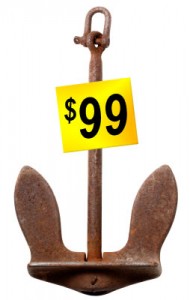How To Use Product Order To Increase Sales
 Whether we are showing products on a web page or offering them in person, if you have more than one product you have a decision to make – the order of presentation. Should you lead with your best product? Close with it for a strong finish? Research shows us several approaches can be successful.
Whether we are showing products on a web page or offering them in person, if you have more than one product you have a decision to make – the order of presentation. Should you lead with your best product? Close with it for a strong finish? Research shows us several approaches can be successful.
When First is Best
New research from Berkeley and Harvard scientists underscores what we know from past research: humans have an inherent preference for the first choice they see. This phenomenon is called the primacy effect.
Bubble Gum and Salespeople
The primacy effect influences choices across many different domains. In one of the experiments, subjects evaluated “salespeople” by looking at photos – pairs of males, females, and teams. When the subjects were asked about their preferences in a questionnaire, they showed no difference in their evaluation of each pair. But, using an implicit association test, a technique to measure subconscious preferences, there was a significant difference in favor of the first-viewed person or team. (For more on implicit association, see The Secret Voter in Your Brain.)
 The second experiment showed subjects two similar packs of bubble gum with different branding. When given a chance to think about their choice, the subjects chose each brand about half the time. But, when instructed to choose quickly, 62% chose the first-viewed item and only 38% chose the second.
The second experiment showed subjects two similar packs of bubble gum with different branding. When given a chance to think about their choice, the subjects chose each brand about half the time. But, when instructed to choose quickly, 62% chose the first-viewed item and only 38% chose the second.
Both experiments indicate a bias toward the first item seen. This bias doesn’t overwhelm all other considerations, and the more a person thinks about a choice the less significant it will be. Still, to use my pet terminology, it’s a NeuroNudge that could help a customer finalize a choice between competing alternatives.
Product Comparisons

As I described in Order Effect Affects Orders, primacy has been shown to be important in comparing similar products. Austrian researchers studied “recommender systems,” i.e., systems that help consumers choose the best product for their needs. Subjects were shown images and descriptions of tents that had various differences in configuration, closures, waterproofing, etc. The tents were displayed in random order. What they found was startling: the subjects did indeed prefer one tent over the rest, by a factor of 2.5 times. The surprise was that this preference wasn’t for one particular tent design; rather, the subjects greatly preferred whichever tent they saw first.
Anchor Effects
 So, are there times when putting the product you think is the best choice for the customer first isn’t the best idea? One good example is real estate, where the products are highly variable and where buyers may have incorrect expectations for prices and amenities.
So, are there times when putting the product you think is the best choice for the customer first isn’t the best idea? One good example is real estate, where the products are highly variable and where buyers may have incorrect expectations for prices and amenities.
When moving between areas with widely differing real estate prices, research by Uri Simonsohn and George Loewenstein shows it can take a year to recalibrate a buyer’s “set point” for prices. That is, a buyer moving to southern California from Indiana will find home prices shockingly expensive upon arrival, and it will take many months to get used to the regional price difference. Of course, real estate agents don’t usually have that long to find a buyer a home, so they adopt a variety of strategies.
One common approach is to save the most likely property – the one that most closely matches the buyer’s needs – for last. Viewing a series of less satisfactory or overpriced properties establishes an anchor in the buyer’s mind. In essence, their initial vague or incorrect expectations begin to coalesce around a value point – “this is what you get for $300,000 in this market.” Then, when their expectations have been recalibrated, the final property seems to offer a superior combination of value and features.
I’m not suggesting that salespeople should make a point to show a client a series of bad choices to make one look good. Rather, if the client is new to the market and will be viewing a series of properties, showing the “perfect” house first may result in a negative reaction not due to the house itself but because of flawed expectations. Saving the best for last may make more sense in this context.
Generalizing from real estate to other products, this approach would seem to be most effective when the customer is unfamiliar with the products and pricing, or may have unrealistic price expectations.
Last, But Not Least!
There’s another bias documented by psychologists – the recency effect. Under some circumstances, the information presented most recently is recalled better and found to be more credible. More than 50 years ago, psychologists Norman Miller and Donald Campbell showed that when two arguments were presented sequentially, they were about equally persuasive. The same was true when there was a one week delay between the two arguments and then another week delay before the subjects’ decisions.
There were two cases where things got interesting. If both arguments were presented sequentially and there was a delay before choosing, the first argument was found more persuasive. That underscores the primacy effect described above. But, if there was a week’s delay between arguments but the subjects chose immediately after hearing the second argument, that argument was more persuasive.
Decoy Effects
 To further complicate things, products can act as decoys – see Decoy Marketing and More Decoys: Compromise Marketing. In both of these articles, I describe how introducing an alternative product that sells poorly itself can greatly increase the sales of other products. These decoy effects, if they kick in, likely outweigh most primacy or recency effects.
To further complicate things, products can act as decoys – see Decoy Marketing and More Decoys: Compromise Marketing. In both of these articles, I describe how introducing an alternative product that sells poorly itself can greatly increase the sales of other products. These decoy effects, if they kick in, likely outweigh most primacy or recency effects.
The First Shall Be First
The lesson from all of this research is that in most cases leading with your best product (the one you think the customer will find most attractive) will help nudge customers toward purchasing that product. You can accomplish this in several ways:
- Show or demonstrate the products sequentially.
- Placing the product first on a multi-product display (e.g., a web page).
- Draw visual attention to that product so that it is viewed first.
If you are involved in a more complicated sales process that takes place over a longer time period, don’t forget the recency effect. What the customer sees more recently will be remembered better, and the ease of recall will create a positive feeling about that item.
Note that the primacy effect is just a nudge, not a big shove. The more the customer deliberates, the weaker the effect will be. And, sometimes, other strategies may work better – showing a customer an expensive product first to produce a price anchor, then a product that is similar but less expensive that will seem more of a bargain and be the likely choice.
Still, purchase decisions often come down to small differences and subconscious leanings – in most cases, you should lead with your best option.
Have you tried different ways to present products? If so, do you find that first is indeed best, or has another strategy worked for you? Share your ideas in a comment!
A portion of this article was adapted from my Forbes post, Why First Is Best.
